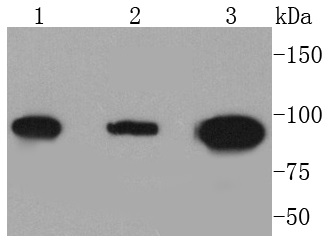Product Detail
Product NameDnmt3b Rabbit mAb
Clone No.SY09-07
Host SpeciesRecombinant Rabbit
Clonality Monoclonal
PurificationProA affinity purified
ApplicationsWB, ICC/IF
Species ReactivityHu, Ms, Rt
Immunogen Descrecombinant protein
ConjugateUnconjugated
Other NamesCytosine 5methyltransferase 3B antibody DNA antibody DNA (cytosine 5) methyltransferase 3 beta antibody DNA (cytosine 5)-methyltransferase 3B antibody DNA (cytosine-5)-methyltransferase 3B antibody DNA methyltransferase HsaIIIB antibody DNA MTase HsaIIIB antibody DNM3B_HUMAN antibody Dnmt3b antibody EC 2.1.1.37 antibody ICF antibody ICF1 antibody M.HsaIIIB antibody MGC124407 antibody RP23-89H14.3 antibody
Accession NoSwiss-Prot#:Q9UBC3
Uniprot
Q9UBC3
Gene ID
1789;
Calculated MW96 kDa
Formulation1*TBS (pH7.4), 1%BSA, 40%Glycerol. Preservative: 0.05% Sodium Azide.
StorageStore at -20˚C
Application Details
WB: 1:1,000-1:2,000
ICC: 1:50-1:200
Western blot analysis of Dnmt3b on different lysates using anti-Dnmt3b antibody at 1/1,000 dilution. Positive control: Lane 1: A549 Lane 2: Hela Lane 3: A431
Methylation at the 5'-position of cytosine is the only known naturally occurring covalent modification of the mammalian genome. DNA methylation requires the enzymatic activity of DNA 5-cytosine methyltransferase (Dnmt) proteins, which catalyze the transfer of a methyl group from S-adenosyl methionine to the 5'-position of cytosines residing in the dinucleotide CpG motif, and this methylation results in transcriptional repression of the target gene. The Dnmt enzymes are encoded by independent genes. Dnmt1 is the most abundant, and it preferentially methylates hemimethylated DNA and coordinates gene expression during development. Additional mammalian Dnmt proteins include Dnmt2 and Dnmt3. Dnmt2 lacks the large N-terminal regulator domain of Dnmt1, is expressed at substantially lower levels in adult tissues, and is likely involved in methylating newly integrated retroviral DNA. Dnmt3a and Dnmt3b are encoded by two distinct genes, but both are abundantly expressed in embryonic stem cells, where they also methylate CpG motifs on DNA.
If you have published an article using product 48739, please notify us so that we can cite your literature.



 Yes
Yes



